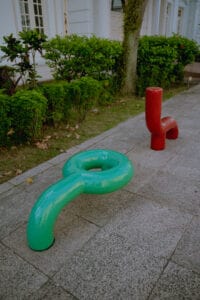Benchmarks: Not just a new art trail
Singapore has introduced yet another art trail, but one that is as functional as it is aesthetic—Benchmarks. The trail was inaugurated on 2 August 2023 and will remain open till 31 July 2026.This is a placemaking initiative commissioned by the Civic District Alliance (CDA), its name a wordplay on the idea of installing artwork benches at various locations in the Civic District, to serve as resting points akin to punctuation marks.

Curated by local multi-disciplinary artist Justin Loke, the artworks are set up in and are inspired from places within the arts and cultural precinct, such as the Asian Civilisations Museum, The Arts House, The Esplanade – Theatres on the Bay and along the Singapore
River.
Significant in that the benches form the first public art trail in the Civic District, they are also a call for visitors to pause and reflect on themselves, their company, or their surroundings, and make meaningful memories in an otherwise frantic day and age.
There are six art benches designed by six Singapore-based artists from diverse disciplines.
Not a Bench by furniture and spatial designer Lua Boon Kai, as its title playfully hints at, is in fact more than just a bench. The installation is quirky in its form and function as a “duo bench” on which you can sit, lean, slump and one that you can even hug.
A Micropolyphonic Stage is musician and composer Joyce Beetuan Koh’s interpretation of a stage against a magnificent skyline. Two French blue benches, shaped as an inverted apostrophe and comma, encircle a tree and invite sitters to listen to a ‘polyphony’ of
conversations with themselves or others. A philosophy which the artist lives by, ‘to understand is to become,’ is printed on the benches and also embellished in braille.
Sayang! Satay Sayang! by Jeffrey Tan is an ode to the now-demolished Esplanade Satay Club that the theatre artist used to often pass by. The use of an exclamation mark is deliberate to ‘call’ people to take a break, share stories and make memories with their loved ones. As a
nod to a city’s culture and ‘code’ which its inhabitants may or may not be privy to, artist-writer Jason Wee created five small units corresponding to the number and length of the characters in the bench’s name, #iykyk, in Morse code.
Adopting a line from the Humpty Dumpty rhyme, …all the King’s men by Yang Jie is almost a resurrection of the Singapore Stone, fashioned as closely as possible in the Stone’s shape. The original stone had fallen from the sandstone destroyed in 1843 to widen the mouth of the Singapore River and build Fort Fullerton, and is now preserved in the National Museum of Singapore.
We say only an ‘almost resurrection’ of the artefact because, taking a cue from kintsugi, the engineer-turned-artist used brass staples to join weathered fragments of granite, enhancing the beauty of the artwork by not attempting to hide any brokenness. “These staples, like stitching, are a soft way to repair hard objects. The repair is an attempt to come to terms with the scars of history.” — Yang Jie
Lastly, in an astounding undertaking, Immanuel Koh fed images of antique furniture and sampans from the Asian Civilizations Museum into an artificial intelligence (AI) model developed by the him, which in turn generated the bench design that was hand-assembled
by artisans.
Holding a PhD in Architecture & AI, the artist’s idea was to re-generate from the past to shape the future, instead of allowing history to fade out. Staying true to the theme of renewal, Koh worked with sustainable furniture maker Saurabh (Sam) Mangla to build Re-store / Neural Artefact Black with upcycled wood from various sources, including old architecture wood from Uttar Pradesh, India and an abandoned sampan which fuelled the design.

“Improvised from 16 models short-listed from infinite possibilities, 6,000 triangular pieces of upcycled wood were laid by hand over almost 3,000 hours to create this bench. To me, this is a coming together of both artificial and artisanal intelligence.” — Immanuel Koh
Just when one was wondering, given how thoughtful and tasteful this series of benches is, whether people would actually sit on them or only use them as a photo-op, one is told the benches have already become popular with the public who can be seen resting on them as if
they were always there.











